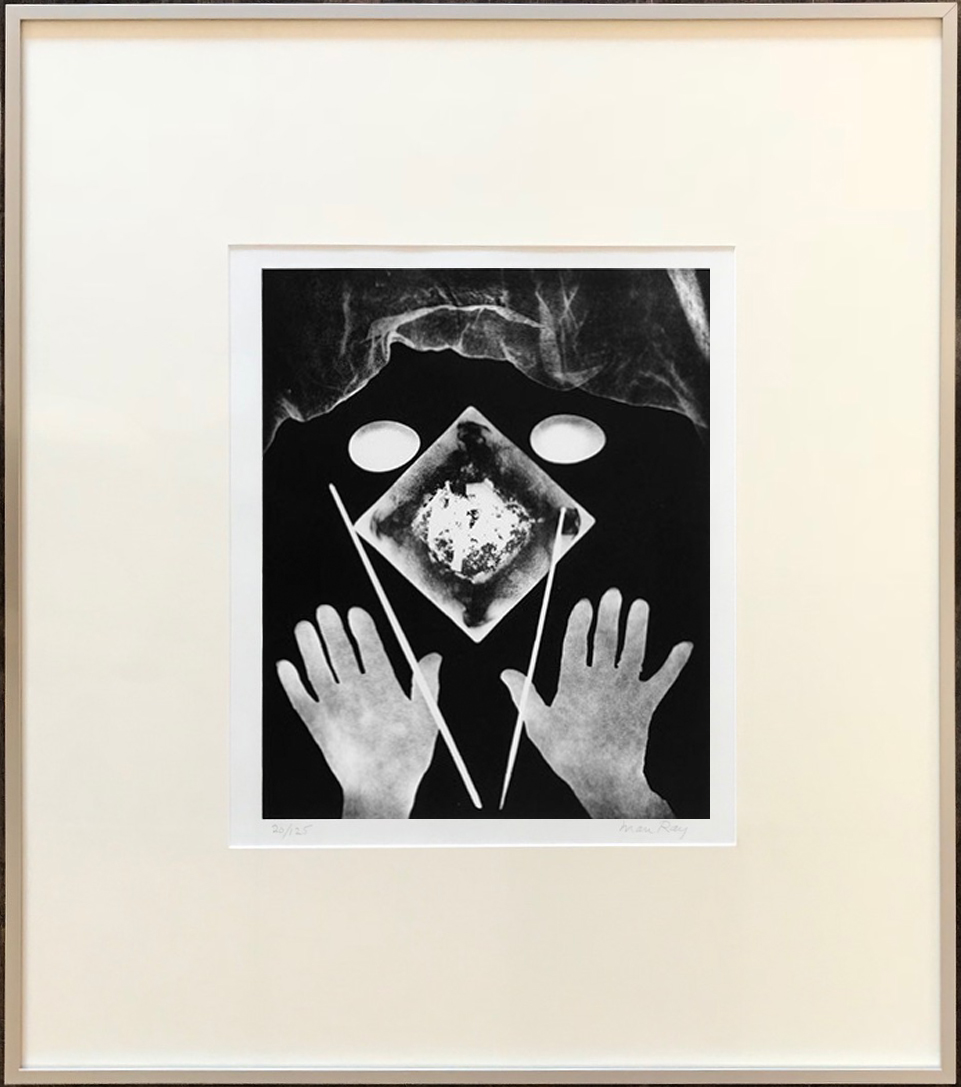Untitled (Two Hands)
Untitled (Two Hands), 1966 by Man Ray is an original lithograph signed in pencil in the lower right margin, and numbered in the lower left margin from the edition of 125. The image size is 16 1/2 x 13 inches. The paper size is 25 1/2 x 22 inches. The frame size is 32 1/4 x 28 1/4 inches. Published by Gemini G.E.L., Los Angeles. Gemini 20.
This Lithograph was made after an original “Rayograph”. Man Ray made his “Rayographs” without a camera by placing objects-such as the thumbtacks, coil of wire, and other circular forms used here-directly on a sheet of photosensitized paper and exposing it to light. Man Ray had photographed everyday objects before, but these unique, visionary images immediately put the photographer on par with the avant-garde painters of the day. Hovering between the abstract and the representational, the rayographs revealed a new way of seeing that delighted the Dadaist poets who championed his work, and that pointed the way to the dreamlike visions of the Surrealist writers and painters who followed.
| Medium | Lithograph |
|---|---|
| Year | 1966 |
| Edition | 125 |
| Signature | Signed, numbered |
| Catalogue Raisonné | Gemini 20 |
| Size | 25.5 x 22 (in) 65 x 56 (cm) |
| Price | SOLD |
Description
Untitled (Two Hands), 1966 by Man Ray is an original lithograph signed in pencil in the lower right margin, and numbered in the lower left margin from the edition of 125. The image size is 16 1/2 x 13 inches. The paper size is 25 1/2 x 22 inches. The frame size is 32 1/4 x 28 1/4 inches. Published by Gemini G.E.L., Los Angeles. Gemini 20.
This Lithograph was made after an original “Rayograph”. Man Ray made his “Rayographs” without a camera by placing objects-such as the thumbtacks, coil of wire, and other circular forms used here-directly on a sheet of photosensitized paper and exposing it to light. Man Ray had photographed everyday objects before, but these unique, visionary images immediately put the photographer on par with the avant-garde painters of the day. Hovering between the abstract and the representational, the rayographs revealed a new way of seeing that delighted the Dadaist poets who championed his work, and that pointed the way to the dreamlike visions of the Surrealist writers and painters who followed.
Born Emmanuel Radnitzky, Man Ray adopted his pseudonym in 1909 and would become one of the key figures of Dada and Surrealism. One of the few American artists associated with these movements, Ray was exposed to European avant-garde artists like Pablo Picasso and Georges Braque at Alfred Stieglitz’s New York gallery and at the 1913 Armory Show. Ray’s photographic works are considered his most profound achievement, particularly his portraits, fashion photographs, and technical experiments with the medium, such as solarization and rayographs (an eponym for his photograms), which were celebrated by the Surrealists. “I do not photograph nature,” he once said. “I photograph my visions.” In 1915 he was introduced to Marcel Duchamp, who would become a lifelong friend and influence; he subsequently moved to Paris, practicing there for over 20 years.
Additional information
| Medium | Lithograph |
|---|---|
| Year | 1966 |
| Edition | 125 |
| Signature | Signed, numbered |
| Catalogue Raisonné | Gemini 20 |
| Size | 25.5 x 22 (in) 65 x 56 (cm) |
| Price | SOLD |




